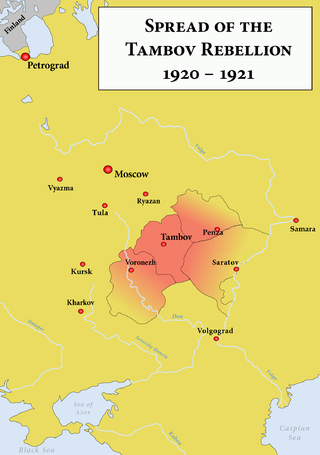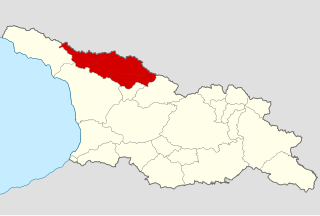
The Democratic Republic of Georgia was the first modern establishment of a republic of Georgia, which existed from May 1918 to February 1921. Recognized by all major European powers of the time, DRG was created in the wake of the Russian Revolution of 1917, which led to the collapse of the Russian Empire and allowed territories formerly under Russia's rule to assert independence. In contrast to Bolshevik Russia, DRG was governed by a moderate, multi-party political system led by the Georgian Social Democratic Party (Mensheviks).

The Tambov Rebellion of 1920–1922 was one of the largest and best-organized peasant rebellions challenging the Bolshevik government during the Russian Civil War. The uprising took place in the territories of the modern Tambov Oblast and part of the Voronezh Oblast, less than 500 kilometres (300 mi) southeast of Moscow.

Svaneti or Svanetia is a historic province in the northwestern part of Georgia. Running along the Greater Caucasus range, Svaneti is one of the most mountainous regions of Georgia. It is largely inhabited by the Svans, an ethnic subgroup of Georgians.

Kaikhosro "Kakutsa" Cholokashvili was a Georgian military officer and a commander of an anti-Soviet guerrilla movement in Georgia. He is regarded as a national hero in Georgia.

The August Uprising was an unsuccessful insurrection against Soviet rule in the Georgian Soviet Socialist Republic from late August to early September 1924.

The Southern Front was a military theater of the Russian Civil War.

The Red Army invasion of Georgia, also known as the Georgian–Soviet War or the Soviet invasion of Georgia, was a military campaign by the Russian Soviet Red Army aimed at overthrowing the Social Democratic (Menshevik) government of the Democratic Republic of Georgia (DRG) and installing a Bolshevik regime in the country. The conflict was a result of expansionist policy by the Russians, who aimed to control as much as possible of the lands which had been part of the former Russian Empire until the turbulent events of the First World War, as well as the revolutionary efforts of mostly Russian-based Georgian Bolsheviks, who did not have sufficient support in their native country to seize power without external intervention.
The Georgian–Ossetian conflict of 1918–1920 were a series of uprisings, which took place in the Ossetian-inhabited areas of what is now South Ossetia, a breakaway republic in Georgia, against the Transcaucasian Democratic Federative Republic and then the Menshevik-dominated Democratic Republic of Georgia which claimed several thousand lives and left painful memories among the Georgian and Ossetian communities of the region.

The Committee for the Independence of Georgia or the Parity Committee was an underground anti-Soviet organization active in the Georgian Soviet Socialist Republic in the early 1920s. It is commonly known as "Damkom". The committee was responsible for the preparation and guidance of the abortive August Uprising of 1924.

Polikarp "Budu" Gurgenovich Mdivani was a veteran Georgian Bolshevik and Soviet government official energetically involved in the Russian Revolutions and the Civil War. In the 1920s, he played an important role in the Sovietization of the Caucasus, but later led Georgian Communist opposition to Joseph Stalin's centralizing policy during the Georgian Affair of 1922. He was executed during the Great Purge.
The Kakhet–Khevsureti rebellion was a rebellion in 1921 against the Bolshevik forces in the Kakheti and Khevsureti regions of Georgia following the Red Army invasion of Georgia.
The 1920 Ganja revolt was a popular uprising against the Soviet occupation that took place in Ganja on 26 to 31 May 1920. The goal of the uprising was to liberate Azerbaijan from the Soviet army and put an end to the arbitrariness of the communists. This was the largest rebellion against Soviet rule in Azerbaijan in the 20th century, and caused the most losses. The organisers and leading force of the uprising were officers of the army of the former Azerbaijan Democratic Republic.

The revolutions of 1917–1923 were a revolutionary wave that included political unrest and armed revolts around the world inspired by the success of the Russian Revolution and the disorder created by the aftermath of World War I. The uprisings were mainly socialist or anti-colonial in nature. Most socialist revolts failed to create lasting socialist states. The revolutions had lasting effects in shaping the future European political landscape, with, for example, the collapse of the German Empire and the dissolution of Austria-Hungary.

The Kronstadt rebellion was a 1921 insurrection of Soviet sailors, naval infantry, and civilians against the Bolshevik government in the Russian port city of Kronstadt. Located on Kotlin Island in the Gulf of Finland, Kronstadt defended the former capital city, Petrograd, as the base of the Baltic Fleet. For sixteen days in March 1921, rebels in Kronstadt's naval fortress rose in opposition to the Soviet government which they had helped to consolidate. Led by Stepan Petrichenko, it was the last major revolt against Bolshevik rule on Russian territory during the Russian Civil War.
The peasant rebellion of Sorokino, officially called the Kulak Rebellion of Sorokino by the Soviet Russian authorities, was a popular uprising against the Soviet policy of war communism in Altai Krai and Kuzbass in central Russia.

Quba Uprising— the uprising by Azerbaijanis against the Soviet occupation in 1920. Hamdulla Afandi Afandizadeh, Kachak Mail, and ADR army officer Afandiyev were leaders of the uprising which lasted about three weeks. Aliheydar Garayev and Levan Gogoberidze were delegated to the region to suppress the uprising. After weeks of unequal clashes, the rebels were defeated. During the uprising, many villages were burned and 400-500 peasants killed.

The Yaroslavl Uprising was an episode of the Civil War in Russia, an anti–Bolshevik protest by the townspeople and members of Boris Savinkov's organization in Yaroslavl on July 6–21, 1918. Suppressed by the forces of the Workers' and Peasants' Red Army. The uprising began untimely, since the Extraordinary Commission by that moment had begun arresting the Moscow branch of the Union for the Defense of the Motherland and Freedom. This inopportune and inability to coordinate with other anti–Bolshevik forces around the region of the uprising predetermined an unfortunate outcome. The lack of reinforcements and ammunition from the rebels also affected.

The Svaneti uprising of 1875–1876 also known as Svaneti-Khalde revolt, was an uprising directed against the policy of Russian Tsar Alexander II's administration in Svaneti. It was the third and the last armed uprising of Georgian mountaineers against the Russian Imperial rule, the other two being the Mtiuleti rebellion of 1804 and the Kakheti revolt of 1812.

Anarchism in Georgia began to emerge during the late 19th century out of the Georgian national liberation movement and the Russian nihilist movement. It reached its apex during the 1905 Russian Revolution, after a number of anarchists returned from exile to participate in revolutionary activities, such as in the newly-established Gurian Republic.

The Chapan rebellion was one of the largest peasant uprising against the Bolsheviks during the Russian Civil War. Taking place in March-April 1919, the uprising covered the territory of Syzran, Sengileevsky, Karsunsky districts of Simbirsk and the Stavropol and Melekessky districts of Samara. It got its name from the clothes of the rebels: the chapan - a winter coat, made of sheepskin, a special robe belted with a sash, a popular clothing among the peasants of the region during cold weather. The uprising was brutally suppressed, and its participants, mostly peasants, were subjected to terror and mass repression.















